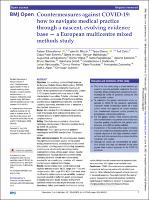| dc.contributor | Vall d'Hebron Barcelona Hospital Campus |
| dc.contributor.author | Eibensteiner, Fabian |
| dc.contributor.author | Ritschl, Valentin |
| dc.contributor.author | Stamm, Tanja |
| dc.contributor.author | Cetin, Asil |
| dc.contributor.author | Schmitt, Claus Peter |
| dc.contributor.author | Ariceta Iraola, Gema |
| dc.date.accessioned | 2021-06-16T11:36:09Z |
| dc.date.available | 2021-06-16T11:36:09Z |
| dc.date.issued | 2021-02-17 |
| dc.identifier.citation | Eibensteiner F, Ritschl V, Stamm T, Cetin A, Schmitt CP, Ariceta G, et al. Countermeasures against COVID-19: how to navigate medical practice through a nascent, evolving evidence base - a European multicentre mixed methods study. BMJ Open. 2021 Feb 17;11(2):e043015. |
| dc.identifier.issn | 2044-6055 |
| dc.identifier.uri | https://hdl.handle.net/11351/6080 |
| dc.description | COVID-19; Política de salut; Nefrologia |
| dc.description.sponsorship | The authors have not declared a specific grant for this research from any funding agency in the public, commercial or not-for-profit sectors. |
| dc.language.iso | eng |
| dc.publisher | BMJ Publishing Group |
| dc.relation.ispartofseries | BMJ Open;11(2) |
| dc.rights | Attribution-NonCommercial 4.0 International |
| dc.rights.uri | http://creativecommons.org/licenses/by-nc/4.0/ |
| dc.source | Scientia |
| dc.subject | Pandèmia de COVID-19, 2020- |
| dc.subject | Nefrologia pediàtrica |
| dc.subject | Centres sanitaris - Mesures de seguretat |
| dc.subject.mesh | Coronavirus Infections |
| dc.subject.mesh | Security Measures |
| dc.subject.mesh | Tertiary Care Centers |
| dc.title | Countermeasures against COVID-19: how to navigate medical practice through a nascent, evolving evidence base - a European multicentre mixed methods study |
| dc.type | info:eu-repo/semantics/article |
| dc.identifier.doi | 10.1136/bmjopen-2020-043015 |
| dc.subject.decs | infecciones por Coronavirus |
| dc.subject.decs | medidas de seguridad |
| dc.subject.decs | centros de asistencia terciaria |
| dc.relation.publishversion | https://bmjopen.bmj.com/content/11/2/e043015 |
| dc.type.version | info:eu-repo/semantics/publishedVersion |
| dc.audience | Professionals |
| dc.contributor.organismes | Institut Català de la Salut |
| dc.contributor.authoraffiliation | [Eibensteiner F] Division of Pediatric Nephrology and Gastroenterology, Department of Pediatrics and Adolescent Medicine, Comprehensive Center for Pediatrics, Medical University of Vienna, Vienna, Austria. Ludwig Boltzmann Institute Digital Health and Patient Safety, Medical University of Vienna, Wien, Austria. [Ritschl V, Stamm T] Section for Outcomes Research, Center for Medical Statistics, Informatics, and Intelligent Systems, Medical University of Vienna, Vienna, Austria. Ludwig Boltzmann Institute for Arthritis and Rehabilitation, Vienna, Austria. [Cetin A] Research Platform Data Science, University of Vienna, Vienna, Austria. [Schmitt CP] Pediatric Nephrology, Center for Child and Adolescent Medicine, Heidelberg University, Heidelberg, Germany. [Ariceta G] Servei de Nefrologia Pediàtrica, Vall d'Hebron Hospital Universitari, Barcelona, Spain |
| dc.identifier.pmid | 33597140 |
| dc.identifier.wos | 000621252500012 |
| dc.rights.accessrights | info:eu-repo/semantics/openAccess |

